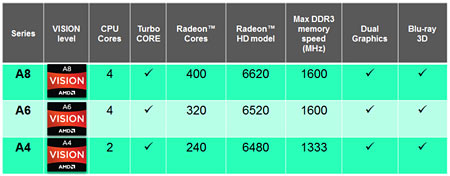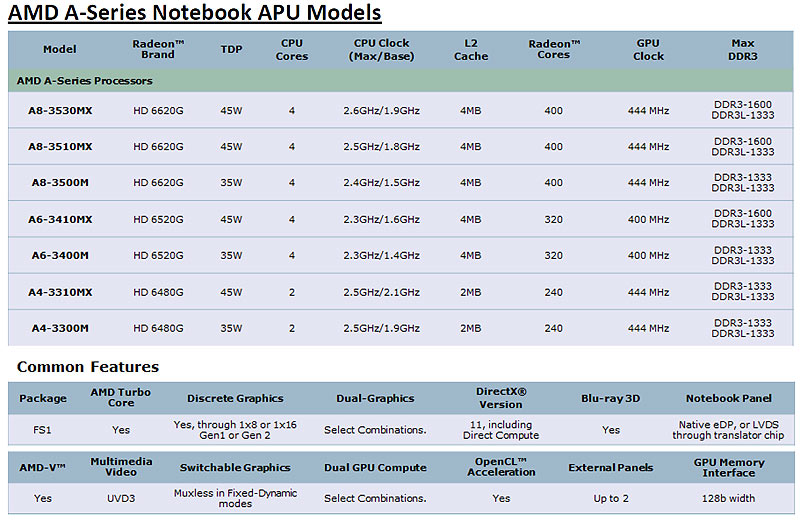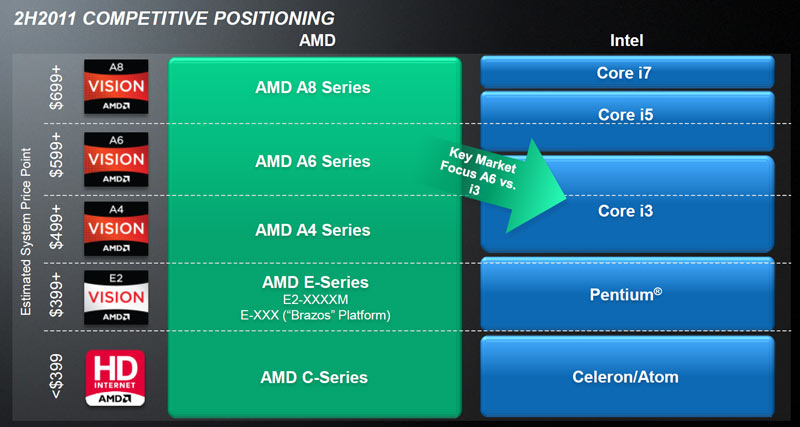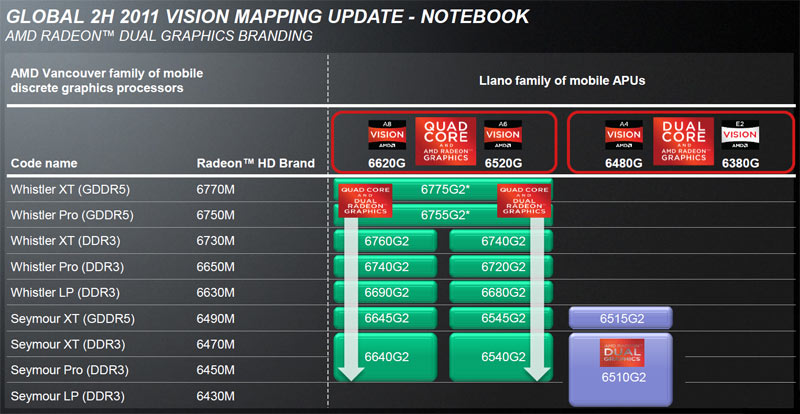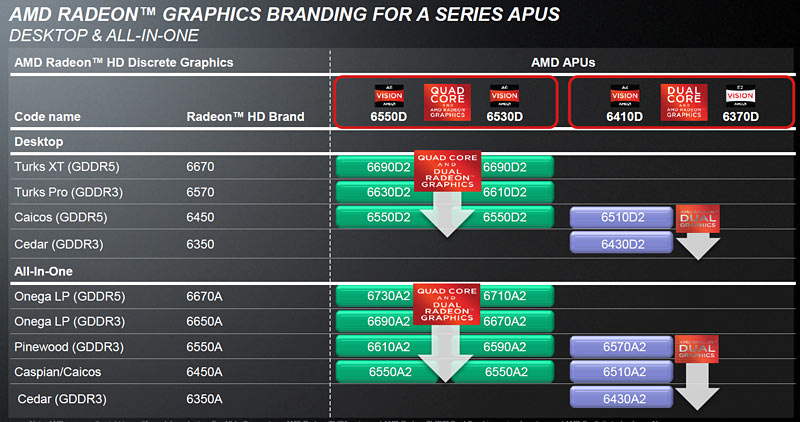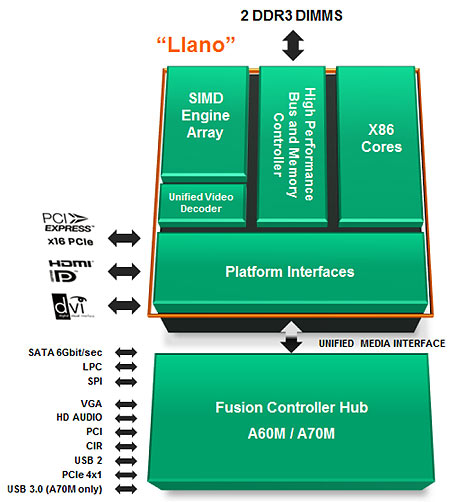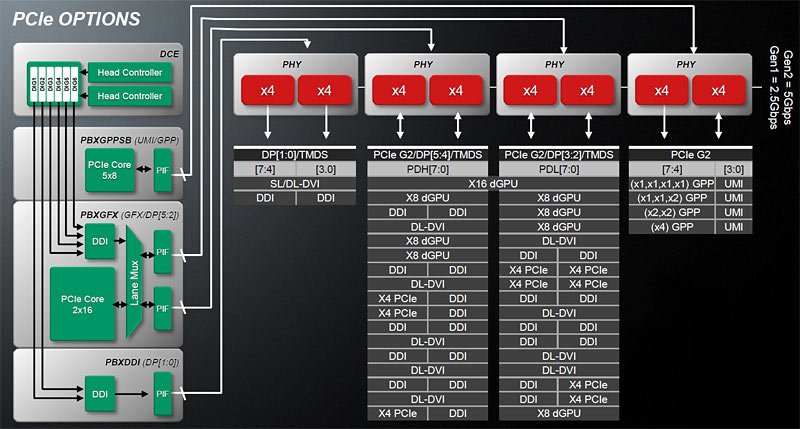The AMD A8-3500M APU Review: Llano Is Unleashed
Code-named Llano, AMD’s first desktop-class APU arrives today. This single-chip combination of the Stars CPU architecture and Radeon graphics brings unique strengths (and weaknesses) to the table, and we’re here to compare them to Intel's Sandy Bridge.
Llano Products And Platforms
In this first look at Llano, we’re concentrating on the notebook platform, code-named Sabine. The mobile product is what’s launching today in a Socket FS1 interface. The upcoming desktop version of Llano does not employ the Socket AM3 interface, nor will it drop into Socket AM3+-equipped motherboards. Desktop-oriented Llano chips require their own unique ecosystem separate from AMD’s familiar platform. Socket FM1 sits at the center of that.
This is definitely a let-down to current Athlon/Phenom owners who might have hoped to upgrade to an APU. However, it makes sense when you consider Llano’s unique graphics engine. Existing AMD chipsets were not designed with this in mind. Moreover, knowing that Llano employs the Stars architecture, it’s unlikely you’d upgrade from an existing processor to Llano anyway. More likely would be a jump to Zambezi, the Bulldozer-based chip expected in the next three months or so. That one will drop in to existing AM3 motherboards.
Llano is officially branded as the Vision A-Series APU. There are three tiers, each armed with different graphics and CPU performance: A4, A6, and A8. If you’re already familiar with Audi’s lineup, this should be pretty easy. A chart is worth a thousand words, so here are the notebook A-series specifications:
Here you can see the major differentiators. A4-series APUs sport a dual-core CPU at various nominal and Turbo Core speeds, in addition to 240 Radeon cores at 444 MHz. The A6-series product employs a quad-core CPU and 320 Radeon cores at 400 MHz. Finally, the top-tier A8-series has a quad-core CPU and 400 Radeon cores at 444 MHz.
Note that these notebook parts are rated for 35 and 45 watts. The upcoming desktop versions are 65- and 100-watt parts. Across the entire A-series family, CPU clocks range from 1.4 to 2.9 GHz, while GPU frequencies are expected to range from 400 to 600 MHz. Since we know the notebook-oriented A8-series APUs are limited to 444 MHz, we’re assuming that it’s the desktop version of Llano that’ll achieve graphics core clocks as high as 600 MHz.
AMD is using two dies to enable the entire portfolio. The company calls its quad-core die Llano 1, composed of 1.45 billion transistors. The A8 lineup puts the entire piece of silicon to use. The A6 leverages Llano 1 as well, however, parts of the chip are disabled to yield 320 of the possible 400 Radeon cores. The dual-core die is designated Llano 2 and equipped with 758 million transistors. The first A4-series APUs will be artificially handicapped Llano 1-based parts, though a smaller, more affordable alternative is on its way to help cut costs. AMD plans to use the same hardware on the desktop side, so expect to see Llano 1 and Llano 2 crop up there, too.
It’s interesting that AMD is only selling dual- (A4) and quad-core (A6 and A8) models initially. With APUs featuring the same thermal limits, we might actually see an A6 able to outperform an A8 in applications that tax CPU cores. With the smaller GPU requiring less power, there could be more thermal headroom available to keep the processor accelerated via Turbo Core for longer amounts of time. In any case, the clock speeds fall within such a tight range that traditional processor benchmarks will likely demonstrate very similar performance. Clearly, AMD is counting on GPU performance to differentiate the A6- and A8-series parts. Frankly, it’s a little surprising that the A6 didn’t turn out to be a triple-core contender.
Get Tom's Hardware's best news and in-depth reviews, straight to your inbox.
Enthusiasts, prepare for disappointment: Llano’s clock multiplier is locked, and there won’t be any Black Edition parts.
Positioning and Pricing
AMD provided no concrete pricing of any kind, instead suggesting estimated price points for notebook products that feature its Llano APU. Of course, laptop manufacturers will come up with their own pricing, so even these rough figures are ballpark at best. Assuming reality is somewhere in line with this chart, the A-series APU could potentially change the current pricing landscape. Based on Radeon core count alone, AMD’s Llano design stands to give the sub-$700 notebook market graphics performance previously unavailable there. You’ll see for yourself here shortly, but I don’t think you’ll be too surprised to learn that the A8-series APU and its 400 Radeon cores eat Intel HD Graphics 3000 alive in games.
Dual Graphics
The Radeon cores in a Llano APU are capable of working cooperatively with discrete Radeon graphics cards that don’t have the same specifications.
This sounds awesome, but there are fundamental limitations that we’ll dig into. To that end, AMD made a marketing decision we’re afraid may confuse the uninitiated. Multi-GPU graphics solutions are to be branded with a single Radeon HD numeric designator based on the APU and discrete graphics combination according to the following charts:
Let’s clarify how this works with an example: if a laptop has a A6-series APU (designated 6520G graphics), along with a discrete Radeon HD 6490M, then that product is referred to as a Radeon HD 6545G2.
This actually sounds like a good idea on a number of levels. First, the G2 suffix lets the buyer know that the graphics subsystem employs multiple engines. It also gives the customer a relative performance target given other GPUs higher and lower in the stack. The problem is that this performance expectation may be misleading in a number of scenarios that aren’t able to take advantage of both otherwise-independent graphics processors, at which point performance reverts to the lowest common denominator. As we’ll see in the benchmarks, AMD still has driver work to do before its already-named model numbers are actually earned.
Memory Support
Llano’s dual-channel memory interface doesn’t drop any surprises on our heads. The FS1-based notebook package can handle up to two SO-DIMMs (one per channel), and the desktop-oriented FM1 interface can handle up to four DIMMS (two per channel). The desktop package supports up to 64 GB of DDR3-1866 (yielding up to 29.8 GB/s bandwidth), and the notebook package accommodates up to 32 GB of DDR3-1600 (up to 25.6 GB/s bandwidth).
But that’s only for the A6- and A8-series APUs. The A4-series’ controller is capped at 1333 MT/s. As far as voltages go, DDR3-1333 is supported at 1.35 V, though the platform can handle 1.5V DDR3 modules from 1333 to 1866 MT/s.
We’ll discuss the memory architecture in detail. But since we’ve broached the subject, note that the GPU has a direct memory path that provides full access to the maximum 29.8 GB/s bandwidth afforded by DDR3-1866. AMD mentioned that side-band memory dedicated to the GPU and GDDR5 support are some of the additions it’ll be considering in future implementations. The company is well aware that bandwidth bottlenecks are the bane of an effective graphics subsystem. Nevertheless, it’s also proud to point out that Llano delivers four times the bandwidth between the GPU and memory compared to previous IGP solutions like 880G. Additionally, Llano eliminates the latency and power usage of a motherboard armed with its own integrated GPU.
The Southbridge, Now Known As The Fusion Controller Hub
The Sabine platform is a two-chip solution, and the APU must be paired to a Fusion Controller Hub (FCH) to provide expanded I/O options, similar to Intel and its Platform Controller Hub. There are two different models available. The premium A70M FCH is USB 3.0-capable, with four USB 3.0, 10 USB 2.0, and two USB 1.1 ports. The A60M is the value proposition with 14 USB 2.0 and two USB 1.1 ports, but no USB 3.0 option.
These hubs are otherwise identical. They both offer SATA 6Gb/s support, second-gen PCIe links, an integrated DAC to support VGA output, and an integrated clock generator like P67/H67.
Display And I/O Support
The display and I/O blocks are some of the most complex parts of the Fusion APU. There are a total of 32 PCIe lanes. Two four-lane links are dedicated to independent DisplayPort, DVI, and HDMI outputs. An additional 16 lanes (cut up into a quartet of four-lane links) enable discrete graphics, and those can be subdivided into two x8 connections if you want to implement CrossFire. That leaves eight lanes for other purposes.
AMD divides those remaining lanes into a four-lane link called the Unified Media Interface to one of its Fusion Controller Hubs and a four-lane link used to keep high-I/O peripherals from taxing the FCH. Think add-in storage controllers, a PCI Express-based SSD, or something like a multi-port gigabit Ethernet adapter.
Don Woligroski was a former senior hardware editor for Tom's Hardware. He has covered a wide range of PC hardware topics, including CPUs, GPUs, system building, and emerging technologies.
-
fstrthnu AMD is kind of in a fix here, the more enthusiast gamers won't even bother looking at the Llano computers while this is kind of overkill for casual gamers. MAYBE money-pressed college students or something, but most people will just skip this and either buy a regular gaming computer or build their own using one of the guides from this very site! Going for good graphics in cheap desktops is kind of a futile exercise, the people who will care will just get the more expensive stuff anyways. Notebooks are more understandable, but the prices on the decent gaming desktops are just too good for Llano to be very competitive (and also, the CPU portion will be a letdown for the average person. Noticeably slower than the comparable Intel Core i5.)Reply -
stingstang Good job, AMD. You finally made a better cpu/gpu combo than intel in terms of graphics power.Reply
....big win there... -
vz7 After reading the desktop benchmarks on anandtech I can't say I'm impressed. The top of the line a8 3850 manages to scratch the best intel integrated graphics, which doesn't say much. Its CPU power seems to be a toss up with the i3. I think this hardly justifies the +70 premium (over an i3) that you'd have to spend to get it.Reply -
billj214 This APU being somewhat low power and good graphics almost deserves to be in a tablet PC since CPU processing is not critical in tablet PC's and graphics is something that can help with media and games.Reply
Ditto on the "Good Job AMD" definitely on the right track. -
cangelini vz7Do you know when the desktop review for llano will be out?Reply
The NDA is up on the 30th. -
niceview two things:Reply
1) What happened to the Game Charts results for the Radeon HD 5570, when the games were benchmarked? I thought you made a point to say you were going to compare the APU's 6620G with a discrete card (that has the same number of SPs and same clock). So much for that, unless you thought only comparing the two with a synthetic test was enough. Oh well. Tom's can be such a tease!
2) I'm just a little disappointed that the APU's graphics power was not able to double Intel's.... Under the best of circumstances, AMD's latest integrated graphics came close to being twice as fast, but i guess that is ok since we are not playing horseshoes. I just thought it would be nice if it had made a nice even doubling, or more. Now, i'm worried IVY BRIDGE will beat it.... -
niceview sorry, i guess that should be:Reply
we ARE playing horseshoes...
and i have to give credit where credit is due: props to AMD for almost doubling Intel's HD Graphics in the integrated space....
